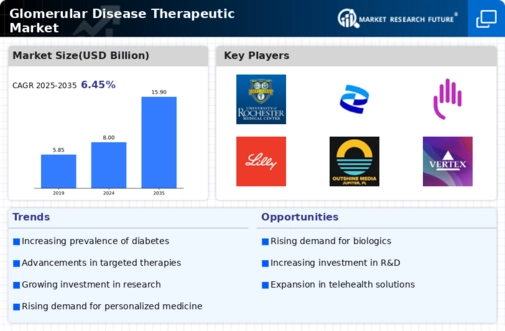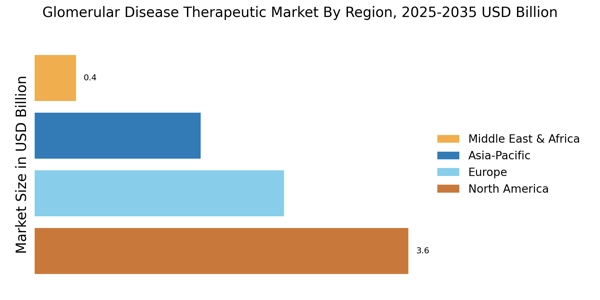Rising Prevalence of Glomerular Diseases
The increasing incidence of glomerular diseases, such as focal segmental glomerulosclerosis and minimal change disease, is a primary driver of the Glomerular Disease Therapeutic Market. Recent estimates indicate that these conditions affect millions worldwide, leading to a heightened demand for effective therapeutic options. As awareness of kidney-related disorders grows, healthcare providers are more likely to diagnose and treat these diseases, further propelling market growth. The rising prevalence is also linked to lifestyle factors, including obesity and diabetes, which are known to exacerbate kidney conditions. Consequently, pharmaceutical companies are focusing on developing innovative treatments tailored to these specific diseases, thereby expanding their portfolios and addressing unmet medical needs. This trend suggests a robust market potential for therapies targeting glomerular diseases.
Growing Awareness and Education Initiatives
Increased awareness and education initiatives surrounding kidney health are pivotal in driving the Glomerular Disease Therapeutic Market. Organizations and healthcare providers are actively promoting knowledge about glomerular diseases, their symptoms, and the importance of early diagnosis. This heightened awareness is leading to more patients seeking medical attention, which in turn boosts the demand for therapeutic interventions. Educational campaigns are also focusing on risk factors, such as hypertension and diabetes, which contribute to kidney diseases. As patients become more informed, they are more likely to engage in preventive measures and seek appropriate treatments, thereby expanding the market. The emphasis on education is expected to continue, fostering a more proactive approach to kidney health and treatment options.
Regulatory Support for Innovative Therapies
Regulatory bodies are increasingly supporting the development of innovative therapies for glomerular diseases, which is a significant driver for the Glomerular Disease Therapeutic Market. Initiatives aimed at expediting the approval process for new drugs, particularly those addressing unmet medical needs, are becoming more common. For example, the designation of orphan drug status for certain glomerular disease treatments can provide incentives for pharmaceutical companies to invest in research and development. This regulatory support not only encourages innovation but also enhances market entry for new therapies. As a result, the landscape for glomerular disease treatments is evolving, with more options becoming available to patients. This trend is likely to stimulate competition among manufacturers and ultimately benefit patients through improved access to effective therapies.
Increased Investment in Healthcare Infrastructure
The ongoing investment in healthcare infrastructure is a crucial driver of the Glomerular Disease Therapeutic Market. Enhanced healthcare facilities and improved access to diagnostic tools are facilitating earlier detection and treatment of glomerular diseases. Governments and private entities are allocating resources to upgrade healthcare systems, which includes the establishment of specialized kidney care centers. This investment is expected to lead to better patient outcomes and increased demand for therapeutic options. Furthermore, as healthcare systems evolve, there is a growing emphasis on integrated care models that encompass prevention, diagnosis, and treatment of kidney diseases. This holistic approach is likely to create a more favorable environment for the development and adoption of new therapies, thereby propelling the market forward.
Advancements in Biologics and Personalized Medicine
The Glomerular Disease Therapeutic Market is witnessing a transformative shift due to advancements in biologics and personalized medicine. These innovations allow for the development of targeted therapies that cater to the unique genetic and molecular profiles of patients. For instance, monoclonal antibodies and other biologics have shown promise in treating various glomerular diseases, leading to improved patient outcomes. The market for biologics is projected to grow significantly, with estimates suggesting a compound annual growth rate (CAGR) of over 10% in the coming years. This growth is driven by the increasing understanding of disease mechanisms and the ability to tailor treatments accordingly. As more personalized therapies emerge, they are likely to enhance the efficacy of treatments, thereby attracting investment and interest within the Glomerular Disease Therapeutic Market.


















Leave a Comment